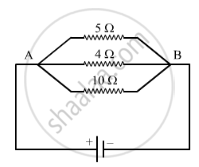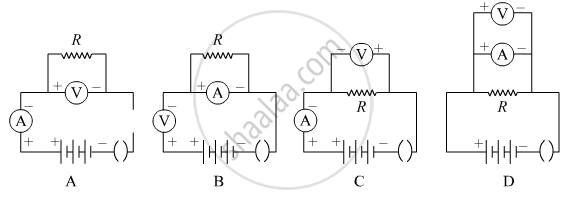Advertisements
Advertisements
प्रश्न
In the circuit shown below:

The potential difference across the 3 Ω resistor is:
पर्याय
`1/9`V
`1/2` V
1 V
2 V
उत्तर
1V
The resistors of 1 Ω, 2 Ω and 3 Ω are connected in series. Therefore, the net resistance,
R = R1 +R2 +R3
R = 1 Ω + 2 Ω + 3 Ω = 6 Ω
Current in the circuit will be,
I = V/R
or I = 2/6 = 1/3 A
Current = `1/3`A
Therefore, the voltage across the 3 Î resistor,
V = IR
or V= `1/3xx3` = 1 V
APPEARS IN
संबंधित प्रश्न
Name a device that helps to maintain a potential difference across a conductor.
A potential difference of 20 volts is applied across the ends of a resistance of 5 ohms. What current will flow in the resistance?
Keeping the potential difference constant, the resistance of a circuit is doubled. By how much does the current change?
The potential difference between the terminals of an electric iron is 240 V and the current is 5.0 A. What is the resistance of the electric iron?
In the circuit diagram given below, the current flowing across 5 ohm resistor is 1 amp. Find the current flowing through the other two resistors.

The device used for measuring potential difference is
A current of 0.2 A flows through a wire whose ends are at a potential difference of 15 V. Calculate:
(i) The resistance of the wire, and
(ii) The heat energy produced in 1 minute.
State whether the potential is a scalar or vector?
Which one of the following is the correct set-up for studying the dependence of the current on the potential difference across a resistor and why?

An electric bulb draws 0.5 A current at 3.0 V. Calculate the resistance of the filament of the bulb.
